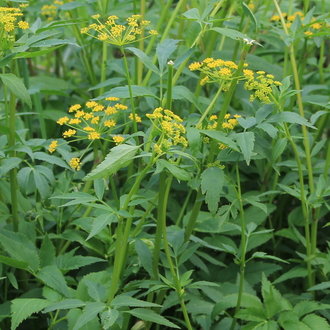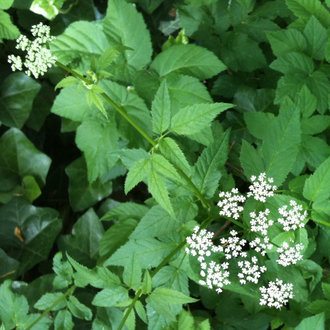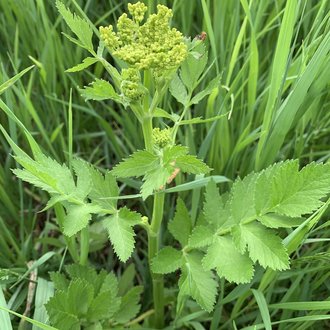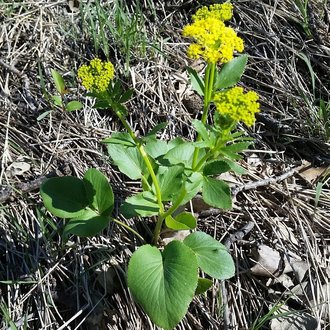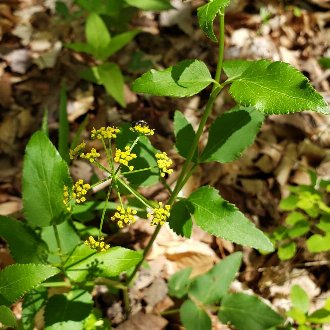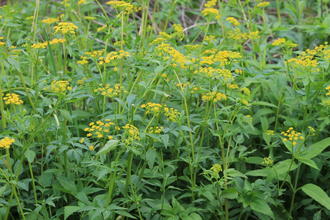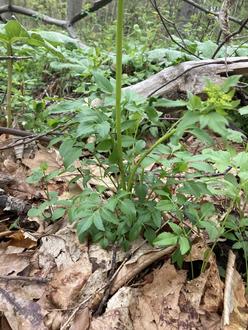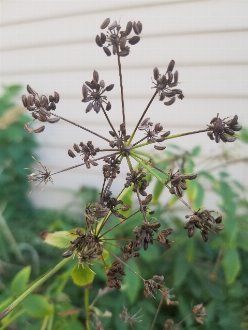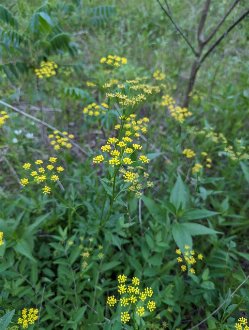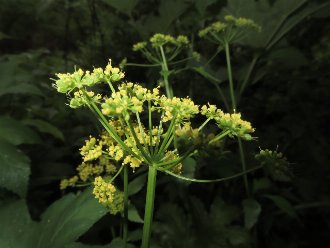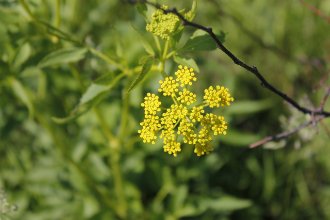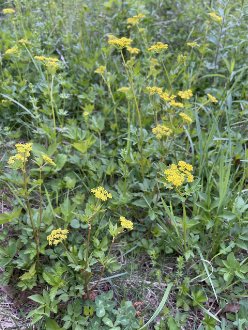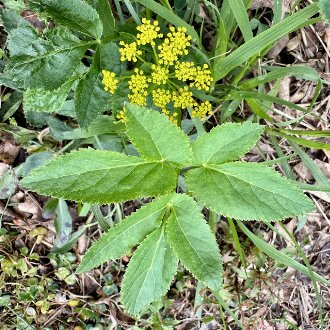Golden Alexanders (Zizia aurea (L.) W.D.J. Koch)
Also known as golden zizia; also classified as Smyrnium aureum.
↑Summary
A carrot-family perennial of moist to mesic, sunny areas, with yellow blossoms, native to eastern North America.
↑Range - Expand
| Legend | Color |
| Native | |
| Native or Not Present |
This tentative map is based on our own research. It may have limited data on Canada and/or Mexico, and there is some subjectivity in our assignment of plants as introduced vs. expanded. Read more in this blog post.
Although this plant occurs somewhere in each of these regions, it may only occur in a small part of some or all of them.
↑Description & Identification
This species is frequently confused with other yellow-flowering plants in the Selineae tribe. It can be distinguished by (except on seedlings) all of its leaves, even basal leaves, being compound, by its leaves being doubly-compound and not singly-pinnately compound, by its leaves and leaflets usually lacking strongly cordate bases, by its seeds being ridged but not strongly winged, and by the central flower of each cluster lacking a stem or having only a very short stem.
↑Similar Plants
↑Habitat
Found in a variety of moist grasslands and moist-to-mesic partly-wooded areas, including moist black soil prairies, meadows, savannas, shores of rivers and lakes, limestone glades, thinly-wooded bluffs, and other openings in woodlands. Also occurs in many anthropogenic habitats, including abandoned fields, power-line clearances through forests, and forest paths wide enough to let light through the canopy. Also readily forms wild or naturalised populations in suburban gardens where it can colonize mulch beds as well as more natural substrates.
Found on soils that tend to be moist, but can tolerate dry conditions during summer. Best growth is on wet soils. Tolerant of temporary flooding, and can grow in drier portions of wetlands. Tolerates a wide range of soil textures, typically growing best on loamy soils but also tolerating some rocky material, sand, and clay, but usually absent from the most poorly-drained soils. Soil tolerances may vary regionally.
Tolerates a range of soil pH, including alkaline soils to mildly acidic, but absent from the most acidic soils. We found conflicting references of this plant's pH tolerance, with some sources saying it requires pH >= 6.0, but it can likely tolerate lower than this.
Light needs range from full sun to light shade under trees; usually requires at least 2 hours of direct sunlight.
Highly tolerant of fire and can be found in habitats that burn regularly, as well as those that do not.
↑Life Cycle
This species is a clumping perennial.
Seedlings germinate above ground, and typically grow one or more simple leaves, after which subsequent leaves are compound. Mortality of seedlings on suitable sites is low; the seeds contain enough energy reserves to allow plants to quickly grow substantial roots and foliage and sustain both some drought and/or competition from other plants.
New plants usually do not flower in their first year; most commonly, plants flower in their second year, but plants suppressed by shade or otherwise in poor growing conditions may delay flowering longer. Plants usually do not reach their full extent until their third or later year.
Initially, plants grow only a basal rosette of leaves. Flowering plants grow a series of stems, which may grow upright if supported by other vegetation, but which sprawl out in the absence of supporting vegetation. The stems still have significant foliage, allowing them to capture greater light both in the scenarios of competing vegetation or sprawling stems covering exposed ground. The sprawling habit can help this plant to adapt to areas where soil moisture and fertility is patchy, such as rock outcroppings or ravines with pockets of moist, fertile soil in between areas of rock or poor, thin, or dry soil, as well as disturbed or anthropogenic habitats with such patchiness caused by paved surfaces.
Plants bloom during mid to late spring, usually ending by early summer. Although primarily insect-pollinated, flowers are capable of self-pollination. Seeds mature in summer, with many of them falling off the plant quickly, but others staying on the stems long after the stem has died, sometimes even into winter. Seeds primarily fall close to the parent plant; short-distance distribution is aided by sprawling or horizontally-growing stems. Seeds are occasionally spread over longer distances by seed-caching birds, or by dropped or undigested seeds carried by other birds.
Seed germination is staggered and highly variable. The germination rate in a given year is typically low in the absence of disturbance, and this species often forms a long-term seed bank. However, a small portion of seeds germinate immediately after falling. Seeds may be triggered to germinate by fire, especially high-intensity ground fires that clear most of the litter, and can also be triggered by other disturbances that expose the ground, including artificial ones such as mowing. Germination tends to occur during periods where temperatures are warm, from mid-to-late spring through autumn; this species is not usually among the first to emerge in spring.
The staggered seed germination in this species can allow it to persist in a range of habitats with different disturbance regimes, as well as allowing it to persist in habitats experiencing irregular disturbance.
Under some circumstances, plants will produce a second flush of blooms later in the season.
Stems and upper foliage die back after seeds mature, but basal rosettes remain evergreen in milder climates.
Over time, individuals will grow more vigorous and reproduce vegetatively but only over short distances of a few inches a year at most, by dividing at the base. Plants usually live about 5-10 years.
↑Faunal Associations
The flowers are attractive to a wide range of insects, which seek both nectar and pollen, particularly short-tongued bees, including metallic green bees (Agapostemon sp.), masked bees, mining bees (Adrenid sp.), and also wasps, including Potter wasps (Eumeninae), spider wasps (Pompilidae), ichneumon wasps, digger wasps (Crabroninae), as well as various flies and beetles. One bee, the golden alexanders miner bee (Andrena ziziae), specializes on this species. Less common flower visitors include long-tongued bees, small butterflies, and true bugs.
The leaves are eaten by the larvae of the eastern black swallowtail (Papilio polyxenes) butterfly, as well as the Ozark swallowtail (Papilio joanae), both of which prefer this and other related plants within the carrot family, and the caterpillars of the rigid sunflower borer moth (Papaipema rigida) eat the inside of the stems of this and other, less closely related plants. Two aphids, Aphis saniculae and Aphis thaspii eat the sap of this and other plants in the carrot family.
The foliage is somewhat toxic to mammals and is usually ignored or browsed only minimally by mammalian herbivores such as deer and rabbits.
The seeds are eaten by various songbirds.
↑Uses
Occasionally used as a garden plant; its use is increasing. It is valued for being easy to grow in most garden settings, for its support of insects, resistance to deer and rabbits, and for its showy blooms which occur at a time where few other cultivated flowers are blooming.
Also used in ecological restoration projects, where it is relatively easy to seed into an area, although it often takes several years to establish. Adapts readily to disturbed and degraded habitats and competes favorably with a number of invasive plants.
↑Related Plants
Two other Zizia sp. occur in North America, both native, and both overlapping with this one in range: meadow zizia (Zizia aptera) ranges farther west in the northern portion of its range, whereas meadow alexanders (Zizia trifoliata) has a more limited distribution in the southeast.
There are numerous other plants in the broader Selineae tribe. It may be particularly closely related to Polytaenia sp., of which three are native to North America, and also Aletes sp. and Musineon sp., which together make up 6 species native to Western North America.
↑Links & External Resources
• Zizia aurea (Golden Alexanders) | Illinois Wildflowers (About This Site)
• Zizia aurea (Golden Zizia) | USDA PLANTS Database (About This Site)
• Zizia aurea | Go Botany (About This Site)
• Zizia aurea (Golden Alexander) | Missouri Botanical Garden Plant Finder (About This Site)
• Zizia aurea | Biota of North America Project (BONAP) (About This Site)
• Zizia aurea | NatureServe Explorer (About This Site)
• Zizia aurea | Missouri Plants (About This Site)
• Golden Alexanders | Maryland Biodiversity Project (About This Site)
• Zizia aurea (Golden Alexanders) | Minnesota Wildflowers (About This Site)
• Zizia aurea (L.) W.D.J. Koch (Golden-alexanders, Common Golden-alexanders) | Digital Atlas of the Virginia Flora (About This Site)



